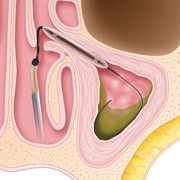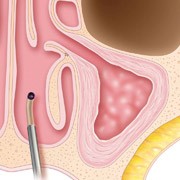Balloon sinuplasty, also known as balloon sinus dilation, is a minimally invasive procedure used to treat chronic sinusitis and other sinus-related conditions. It offers an alternative to traditional sinus surgery by providing relief from sinus symptoms while reducing the risks and downtime associated with more invasive procedures.
What Happens During a Balloon Sinuplasty Procedure?
During a balloon sinuplasty, a small, flexible balloon catheter is inserted into the affected sinus cavity through the nostril. The balloon is then inflated, gently widening the sinus opening and restoring normal sinus drainage and ventilation. The procedure is guided by endoscopic visualization, allowing our ENT specialists to precisely target the affected area while minimizing damage to surrounding tissues.
Balloon Sinuplasty opens blocked sinus cavities in four easy steps

A guidewire and balloon catheter are inserted into the inflamed sinus

The balloon is inflated to expand the sinus opening

Saline is sprayed into the infected sinus cavity to flush out pus and mucus

The system is removed, leaving the sinuses open
What are the Advantages of a Balloon Sinuplasty?
One of the major advantages of balloon sinuplasty is that it preserves the natural anatomy of the sinuses. Unlike traditional surgery, which involves removing or cutting bone and tissue, balloon sinuplasty simply dilates the sinus passages, promoting better airflow and drainage without altering the sinus structure. As a result, it typically results in less bleeding, less post-operative pain, and a shorter recovery period. Most patients can return to normal activities within a few days.
The effectiveness of balloon sinuplasty has been proven in various clinical trials. It has been shown to improve the quality of life of patients suffering from chronic sinusitis significantly, reducing symptoms like facial pain, nasal congestion, and the frequency of infections.
Are There Any Risks with Balloon Sinuplasty?
Like any procedure, Balloon Sinuplasty is also not without potential risks, though these are generally minor and infrequent. They include infection, bleeding, and tissue or mucosal trauma. Also, not all patients with sinusitis are candidates for this procedure. It’s most effective for patients with certain types of sinus blockages.
Who is a Good Candidate for Balloon Sinuplasty?
As mentioned above, not everyone is a candidate for Balloon Sinuplasty. You may be a good candidate for Balloon Sinuplasty if:
- Your sinus issues are located in the frontal (forehead), maxillary (cheek bones) or sphenoid (nasal) sinuses.
- You do not have nasal tumors (polyps)
- You have more mild forms of sinusitis
- You can tolerate the procedure while awake but under local anesthesia which numbs the nasal and sinus passageways.
Balloon Sinuplasty is typically performed on adults but there are cases where children who have not responded to other treatments for sinusitis may be candidates for balloon sinuplasty. These scenarios are pretty limited though.
Remember, if balloon sinuplasty is not the best option for you, you may be a candidate for endoscopic sinus surgery, another minimally invasive outpatient surgical procedure the specialists at ENT Centers of North Texas also use to treat sinusitis. During your consultation, you and your specialist will discuss your treatment options and which may be in your best interest for optimal relief.
In summary, balloon sinuplasty is a minimally invasive procedure that offers an effective and safe alternative to traditional sinus surgery. It provides relief from chronic sinusitis symptoms while preserving the natural anatomy of the sinuses. By improving sinus drainage and ventilation, balloon sinuplasty can significantly improve the quality of life for individuals suffering from chronic sinus conditions.
To learn more about Balloon Sinuplasty and whether it is the right choice for you, contact ENT Centers of North Texas today for a consultation with one of our ENT specialists.
